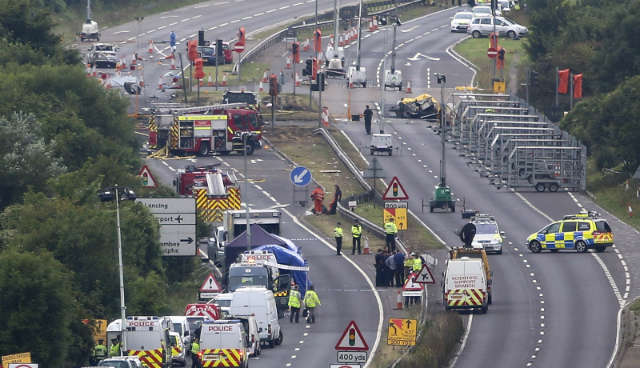It was a perfect summer’s day, with the sun beating down on a large air show crowd, and unbroken blue skies providing a stunning backdrop for displays from vintage aircraft types. It was, in fact, a scene much like that which has been repeated numerous times every year for decades in the UK, where the public has a seemingly unquenchable enthusiasm for aviation.
Following morning attractions including types like de Havilland Tiger Moths, the show commentator raised anticipation levels ahead of the arrival overhead of a classic type hailed for its beauty and elegance.
Barely one minute later, the pilot of the displaying Hawker Hunter failed to pull up from a first manoeuvre at the Shoreham air show, and crashed on a busy main road adjacent to the site. A shocked crowd looked on largely in silence as fire and black smoke rose behind the trees opposite the flightline, with many thinking: but that doesn’t happen in Britain anymore.

Hugo Michiels/LNP/Rex Shutterstock
With 11 deaths confirmed by the time of publication, the Shoreham disaster looks to have been the worst accident of its kind in the UK since a prototype de Havilland DH.110 broke apart above the Farnborough air show in September 1952, killing its two crew and 29 spectators. But the fact that on that occasion supersonic displays were resumed later the same day underscores how much aviation has changed in the ensuing 60-plus years.
As proven at Shoreham, flight safety is still by no means perfect, but the reaction of the show organisers – who cancelled further flying and the event’s planned second day – and the Civil Aviation Authority must be commended. The latter has for now restricted historic jet-powered types to conducting flybys only at over-land events, and halted all flights with other Hunters until more is known about the cause of this tragedy.
To some its decision will appear a knee-jerk reaction, and one leading tabloid newspaper slammed it as “too little, too late” in the wake of the crash. Such criticism fails to consider the huge improvements made to protect air show visitors and innocent bystanders since the risky days when the DH.110 was lost.
Urgent reviews will pull real lessons from the latest disaster, and should reduce the risk of such an event ever happening again. Ultimately, the answer cannot be that air shows should be banned, or that vintage aircraft should be stopped from appearing at them. But if safety must be stepped up again in areas such as display planning and pre-event validation, then change must occur, and fast.
Source: Flight International






















